Introduction
This essay presents a report of a project dedicated to the assessment of the learning needs of a group of nurses in an intensive care unit (ICU). It will offer a definition and explanation of learning needs assessment, describe the target group and predictions for the project and detail the methods used during it. After that, the results of the project will be presented, analysed and used to propose recommendations in the form of an educational program plan. Additionally, the implications of the project and associated problems will be considered and a conclusion will be made. The project demonstrates the importance of educational needs assessments and provides sufficient data for the development of an educational program for the studied ICU.
Background
Education Needs Assessment: An Explanation and a Rationale
Education, learning and training needs assessment (ENA) can be defined as the procedure which aims to determine the areas of study that a particular group should focus on (Aw & Drury,2016,p219; Gaspard & Yang,2016,p1-2). Additionally, the ENA can consider other elements of the educational experience, for instance, the preferred teaching methods and approaches of the target group (Abyad & Banday,2016,p8-9; Fox et al.,2015,p73).
ENA is typically carried out for the development of tailored educational programs (Goudreau et al.,2015,p5; Kilic et al.,2014,p3). To ensure their success, they should take into account the specific knowledge gaps and various forms of educational preferences of the targeted groups (Abyad & Banday,2016,p3; Gaspard & Yang,2016,p1-2). In other words, to make a program learner-centred, which is a requirement for the modern approach to teaching (Waltz, Jenkins, & Han, 2014,p392), ENA is necessary. Thus, the present project focused on establishing the needs of the target group before proceeding with the development of an educational program.
Target Group
The target group consists of the nurses of the ICU of the King Fahad Hospital (KFH) in Almadinah, Saudi Arabia. The reason for choosing this target group is the affiliation of the researcher: since the researcher is a nurse who works in the ICU of KFH, the analysis of the educational needs of the nurses of this establishment is required. Additionally, the target group defined the topics that were presented to the participants as potential options for consideration and the knowledge of the specifics of the work of an ICU nurse assisted the researcher in developing the data collection tool. Thus, the determination of the target group was a crucial element of the project.
Predictions
The predictions were rationalised by the researcher’s knowledge of the specifics of the training of nurses in the ICU. Most nurses of the KFH’s ICU are not provided with direct training on X-ray interpretation. The issue may be related to the fact that the orientation department of the hospital does not seem to consider chest X-ray as a particularly important area of knowledge for ICU nursing.
However, the experience of ICU nurses who have been working with the researcher suggests that chest X-ray is helpful in the settings; for instance, it can be used to determine the correct place for the endotracheal tube. Thus, the topic should be of interest to the respondents and the lack of training on it is likely to result in them reporting a shortage of skills in this field. As a result, the importance of and the lack of knowledge on chest X-ray was the main prediction of the educational needs of the ICU nurses in KFH.
Method
Tool Design and Justification
For the present project, a questionnaire was used as the tool for the ENA. Questionnaires are capable of gathering the perspectives of rather large groups in a resource-efficient manner (Timmins,2015,p42), which are their major advantages. These tools are very widely employed (Rowley,2014,p308) and they can be used in nursing research as well (Timmins,2015,p42). Additionally, questionnaires are commonly applied to ENA (Abyad & Banday,2016,p11-12; Barratt & Fulop,2016,p1-2; Gaspard & Yang,2016,p2; Hennessy & Hicks,2011,p11-13). It is apparent that the purpose of questionnaires suits the aim of the project, which is to gather the nurses’ reports about their educational needs. Therefore, the method fits the project and its advantages justify its use.
The questionnaire of this project includes four major sections: one is targeted at demographics, one considers the topics that the participants want to study, one reviews their self-reported skill levels and one focuses on their educational preferences. These sections used the Likert scale, which is a commonly employed scale that helps to gather the perspectives of participants (Bishop & Herron,2015,p279; Harpe,2015,p838).
Also, its use makes the process of working with questionnaire simpler, which can encourage the participants to complete the procedure (Rowley,2014,p314). Two more questions were open-ended; they invited the participants to list the skills that they would like to train and make any further comments. The latter questions were added to avoid restricting the participants’ options.
It is important to consider the existing questionnaires, which can also be modified as required, before developing a new one (Aw & Drury,2016,p216; Kilic et al.,2014,p3; Timmins,2015,p45). This project’s questionnaire was based on the Hennessy-Hicks Training Needs Analysis Questionnaire and the CME Needs Assessment. Both of the tools consider the perceived importance and level of skills, and both use the Likert scale and open-ended questions (Abyad & Banday,2016,p 11-12; Hennessy & Hicks,2011,p11-13). The idea of an extensive demographics section was taken from Hennessy and Hicks questionnaire (2011,p11).
However, neither of the questionnaires were devoted to ICU; as a result, the topics which they used did not fit the needs of the present project. Thus, the tools were modified to include the questions that are of interest to ICU nurses. The choice of the topics was guided by relevant literature (Guilhermino, Inder, Sundin, & Kuzmiuk,2014,p2; Fleming, Brady, & Malone,2014,p55; Larkin & Zimmanck,2015,p334; Silva et al.,2015,p438.e8). It should be noted that the change of topics is not expected to significantly affect the tools’ reliability or validity (Maher et al.,2017,p308).
The resulting questionnaire was piloted in Melbourne and Saudi Arabia with three nurses in total. The first pilot (in Melbourne) implied that some changes were required, mostly those related to the phrasing of the questions; in particular, the Likert scale was better explained. The second pilot was conducted with no problems identified, after which the tool was deemed ready. All the pilot group nurses supported the chosen topics and did not suggest any new ones.
Thus, the eventual questions covered the arterial blood gas (ABG) interpretation, 12 lead electrocardiography (ECG), central venous pressure (CVP), modes of ventilator, chest X-ray, drug calculation, wound care, tracheostomy care, endotracheal tube care, management of intercostal catheters (ICT) and computer usage based on the literature and the expertise of the developer and testers of the tool.
Implementation Phase
The implementation of the needs assessment project involved the distribution and collection of the questionnaires. First, the questionnaire was sent to one of the KFH workers who printed 33 copies and provided them to the head nurse of ICU. The head nurse proceeded to distribute the copies to the ICU nurses, informing them about the project, its duration (two days) and the fact that the participation in it was voluntary. Additionally, the head nurse placed a box in her office, which was used to gather the filled-out questionnaires. The questionnaires were then sent to the researcher by the same worker who had printed them.
The pen-and-paper approach to questionnaires is a well-established and valid one, even though it is more costly and time-consuming than online versions (Maher et al.,2017,p308; Timmins,2015,p48). The reasons for choosing it were concerned with the lack of researchers’ experience in the development of online questionnaires and the opportunity to use the pen-and-paper version provided by the ICU.
A total of 30 copies were successfully distributed and 25 of them were returned, which constitutes an 83% response rate. This response rate is quite high because questionnaires are typically associated with very low response rates; basically, a response rate above 75% would be considered sufficient for making conclusions (Timmins,2015,p48). The implementation procedures were designed in a way that would ensure their ethical nature.
Ethical Considerations
The ethical considerations of the project were not very extensive because the needs assessment questionnaire did not hold any significant risks. Indeed, the questions could not be considered insensitive and were unlikely to cause any discomfort; other issues, for instance, economic or physical ones, were inapplicable to the project. This situation is common for anonymous questionnaires because they are almost risk-free (Barratt & Fulop,2016,p5). Also, none of the questionnaires that were used to develop the tool showed significant ethical issues; they were anonymous and not insensitive. As a result, no significant ethical concerns were associated with the choice and modification of the tools.
However, the project needed to ensure the voluntary nature of the respondents’ participation and take into account the confidentiality concerns. The nurses were made aware of the fact that they could refuse to participate by the head nurse during the distribution of the copies of the questionnaire; there were no repercussions for not taking or submitting the copy. Furthermore, the design of the tool and the procedure ensured that it would be impossible to determine who returned the questionnaire and who did not.
The tool did not gather any personal information; as a result, the participants remained anonymous. The materials of the project will be kept in a safe location (the researcher’s place) for as long as they are required to prepare the report.
It is also important that the researcher contacted the head nurse of KFH to obtain the permission to conduct the ENA, which was officially granted. Similarly, the nurse director of the researcher also agreed to the questionnaire project with the condition that the results would be provided for the use in ICU. Since the results of the project do not include any personal or identifying information, the condition was deemed appropriate.
Results
After the data collection, it was transferred to the researcher’s computer and analysed with the help of MS Excel, which allows making the following conclusions. The majority of the respondents (more than 83%) were female (see Figure 1); also, most of them (70%) were between 21 and 29 years old (see Figure 2). Additionally, most of the participants (almost 71%) had a diploma, although some of them had a bachelor’s (4%) or master’s (25%) degree (see Figure 3). Furthermore, the majority of the respondents had less than one year of experience in ICUs (see Figure 4) and the same is true for their experience with KFH (see Figure 5).
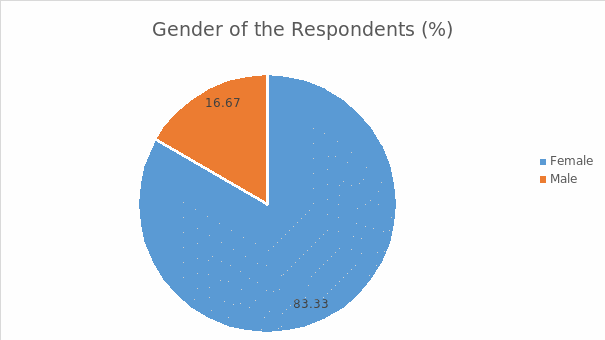
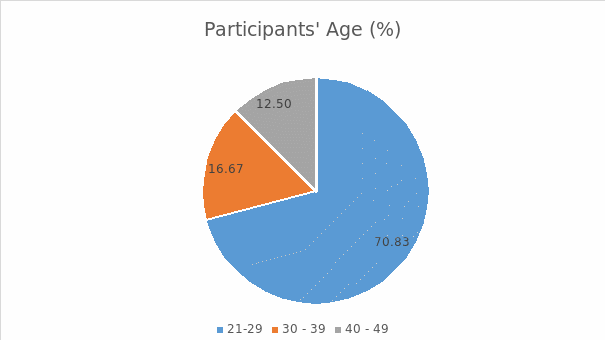
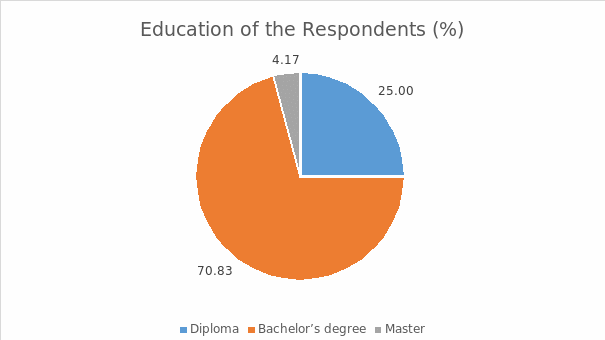
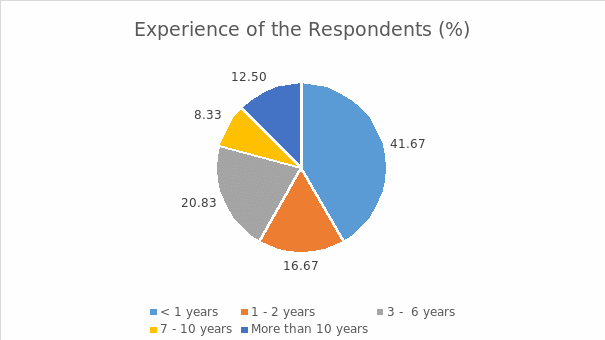
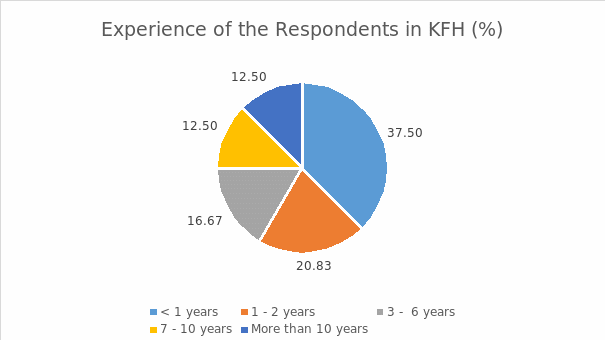
The second section of the questionnaire required considering ICU topics and reporting the importance of receiving some training related to them. The question used a Likert scale, in which number 1 corresponded to the least important topic and number 5 indicated the most important one. The results are presented in Figures 6-16. The topics that were ranked as most important by the majority of the participants (more than 10 people) include ABG interpretation (Figure 6), chest X-ray (Figure 10), drug calculation (Figure 11) and ICT management (Figure 15).
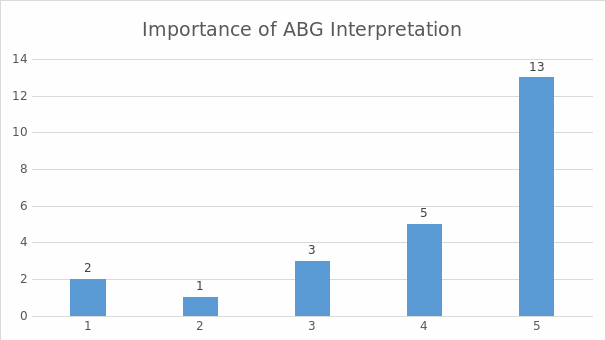


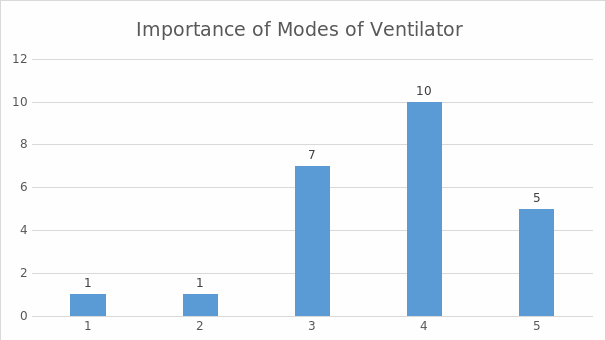
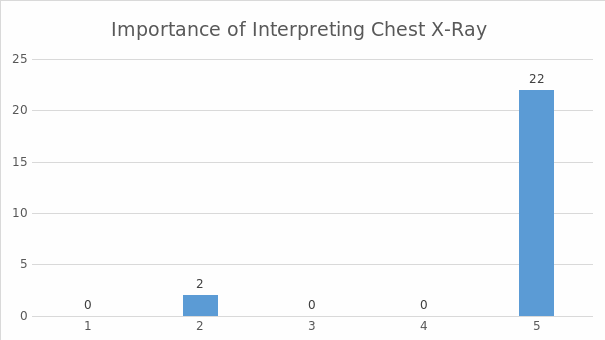
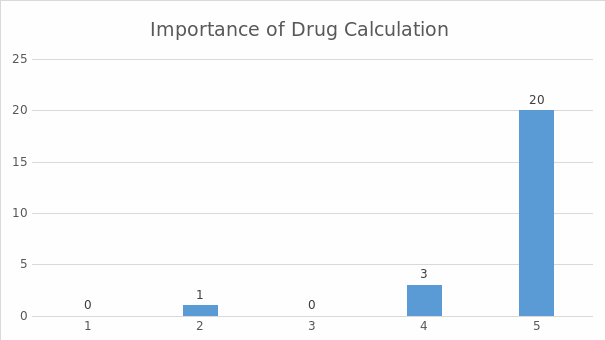
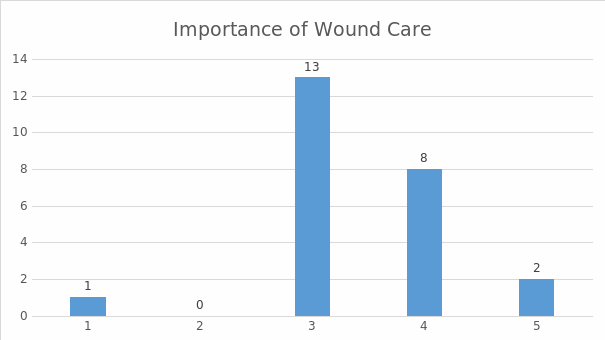
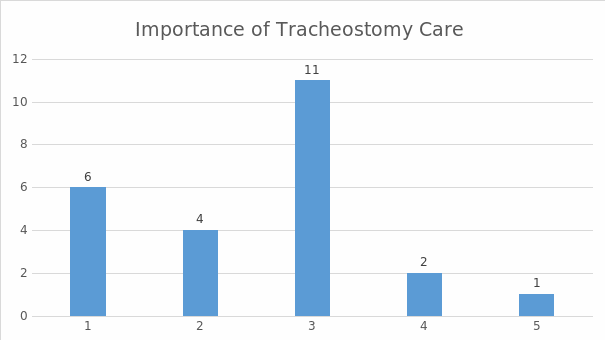
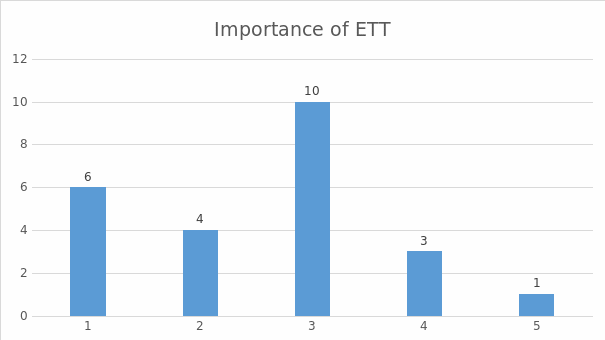
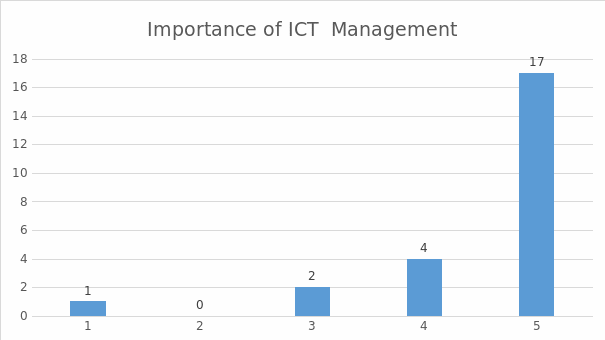
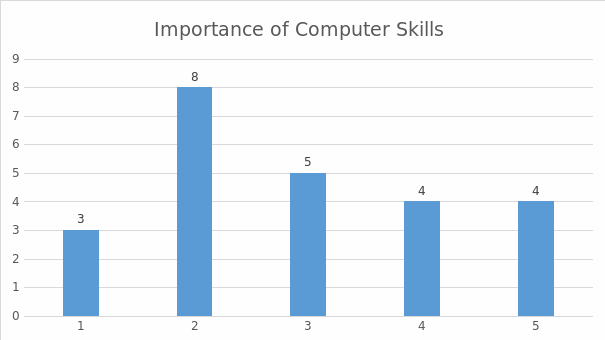
In another section, the participants were asked to report their level of skill with respect to the same topics. The process used a Likert scale again; in it, number 1 corresponded to basic skills and number 5 implied the highest level of skill. Figures 17-28 report the relevant results. The participants were most skilled in tracheostomy care (Figure 24), ETT care (Figure 25) and computer use (Figure 27). They seemed to be the least sure about their skills in chest X-ray interpretation (Figure 21).
For this topic, five nurses reported a low level of skill, 14 nurses suggested that their skills were below the medium level and none indicated a high level of skills. Furthermore, for ABG results interpretation, five nurses used number 2, which can be interpreted as rather low skills and 12 nurses used number 3, which indicates medium skills. The picture was similar for drug calculation (Figure 22) and ICT catheters (Figure 26). With the rest of the topics, more participants reported being skilled in them.
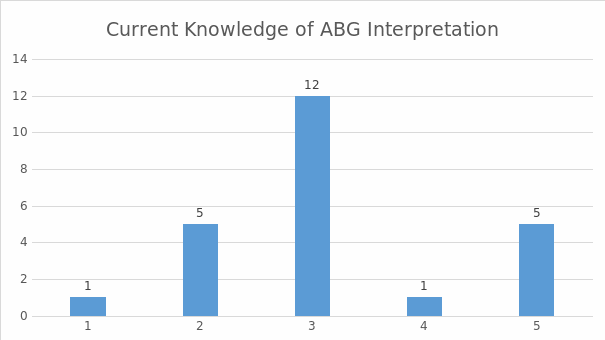
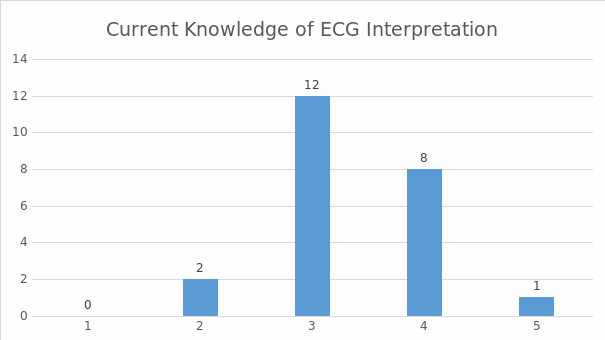
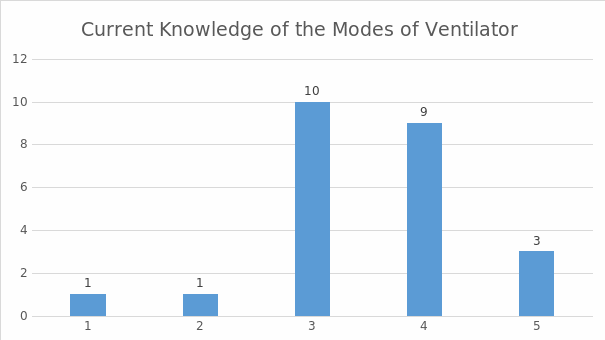
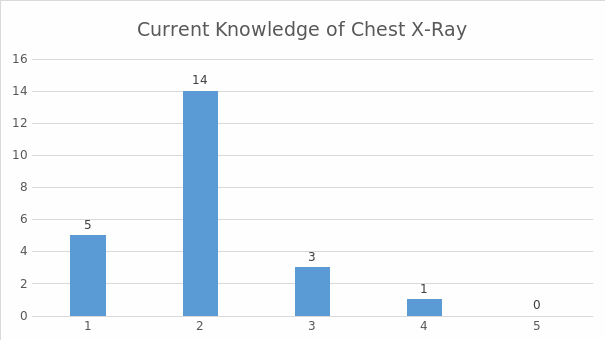
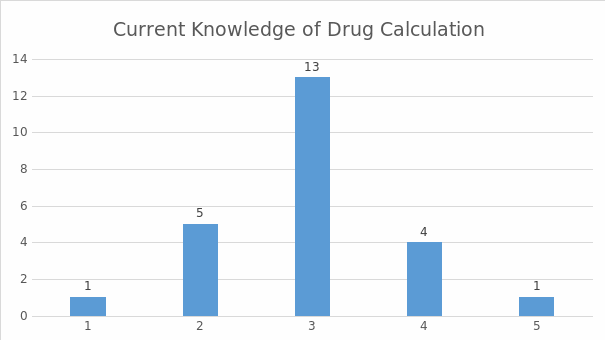

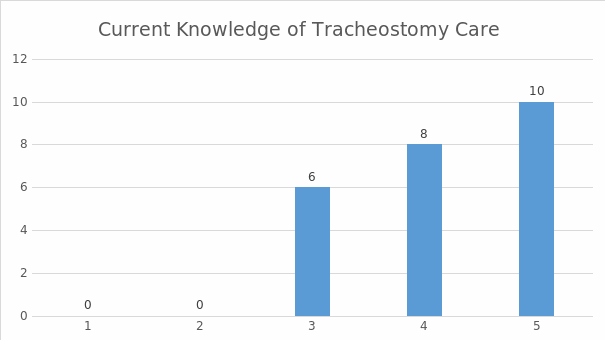
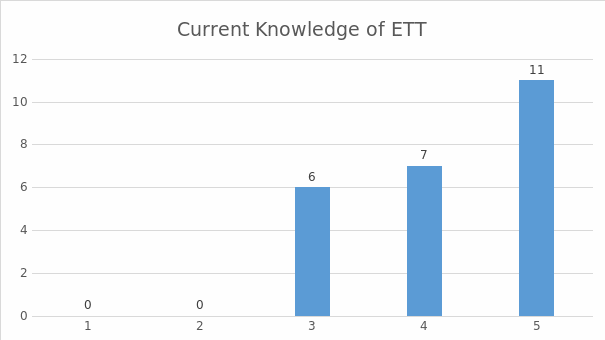
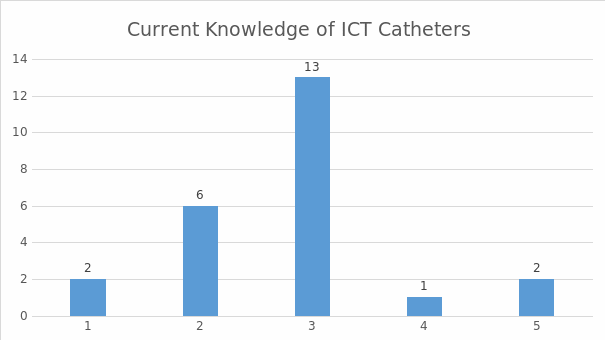
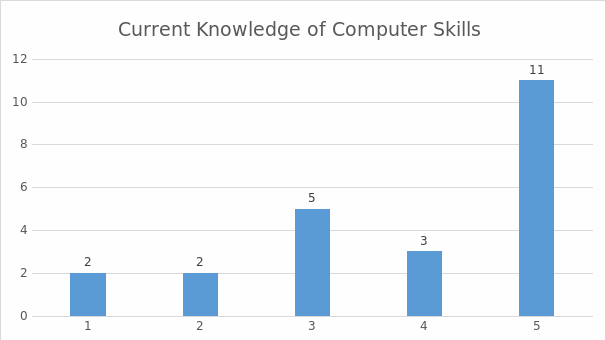
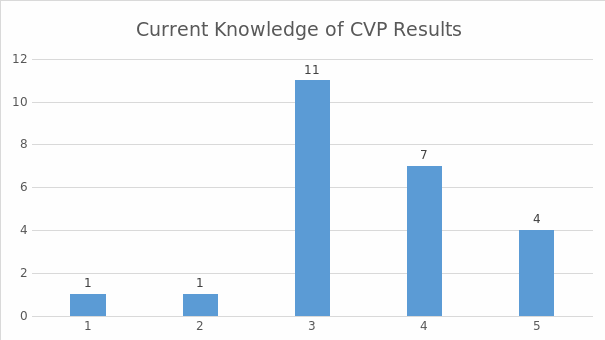
The next section considered the educational preferences of the participants. It also used Likert scales: 1 indicated the least preferred answer and 5 was used to label the most preferred one. 22 participants ranked bulletin boards as the best approach to informing them of educational opportunities and 18 of them considered e-mails to be very convenient. Also, the nurse director possibility was ranked as the best by five people and two people chose flyers. One person listed e-mails as the least convenient option and one also marked the nurse director variant in the same way (Figure 29).
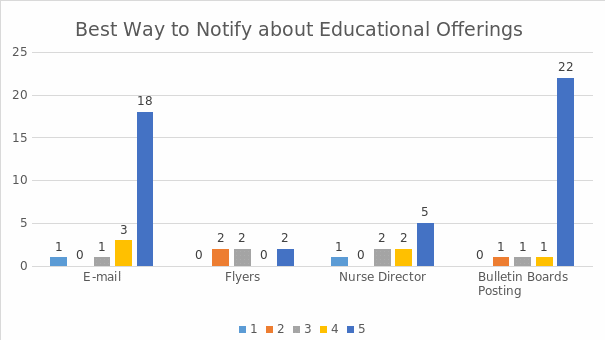
The final question asked the participants to consider different learning methods. 22 people noted that they would prefer classroom lectures and no people labelled this option as the worst one. Also, 16 people viewed bedside training as the best learning opportunity. The handouts were preferred by four respondents and three of them would rather choose online learning. Only online learning was labelled as the least convenient method of learning (Figure 30).

Only three answers to open-ended questions were received. In one of them, one participant explained that they wanted to study chest x-ray; another cited ECG and CVP as important topics. In the final one, a participant thanked the researcher for conducting the needs assessment.
Data Analysis
Analysis and Discussion
The first and last sections of the questionnaire provided the information that can be useful for the development of the program. In particular, the majority of the target group are young and relatively inexperienced nurses with diplomas rather than bachelor’s or master’s degrees. Therefore, it would be better to provide the content in a way that would not prevent less experienced nurses from being able to grasp it. Regarding the educational preferences, bulletin boards and e-mails are the preferred options of informing the nurses about their educational opportunities and the KFH’s ICU needs to use this fact to its benefit. Also, classroom lectures and bedside training seem to be the preferred teaching methods, which is important for the educational program development.
The classroom lectures were an unexpected choice since it is an old-fashioned approach that is typically not very learner-centred (Waltz et al., 2014,p392). However, lectures have been shown to be effective in transferring knowledge, even though more interactive methods are more likely to result in student engagement, which is why the combination of various options can be particularly useful (Presti,2016,p255; Waltz et al., 2014,p394). It should also be pointed out that other learning methods were also chosen by a few people, which offers an opportunity for diversifying the approaches of the program.
As can be seen from the rest of the results, there is a connection between the topics that the nurses rated as important for them to study and the areas in which, according to the respondents, they lacked skill. For instance, only two people ranked chest X-ray as not very important for their study (number 2 in the Likert scale) and only one of the nurses described their skills as quite high (number 4 in the Likert scale) in this area (see Figures 10, 21). This tendency suggests that the responses of the participants are relatively consistent, which makes the results more credible.
The second section of the questionnaire suggests that the topic of X-ray is chosen as the most important one by the majority of the respondents, which implies that it is likely to be the most pressing learning need of the ICU nurses of KFH (Figure 10). Additionally, some other topics were also chosen by more than ten people as the most significant ones: drug calculation (Figure 11) by 20 people and ICT management (Figure 15) by 17 people, and ABG interpretation (Figure 6) by 13 people. The rest of the topics have fewer people indicating their particular importance.
It should be noted that very few nurses described their skills as low (number 1 or 2 in the Likert scale); most of them chose to use number 3. This tendency suggests that those of the areas which do have nurses reporting low skills need to be considered especially closely. In this respect, the topic of chest X-ray seems to be particularly important (Figure 21) as no other area has a similarly large number of nurses reporting low (number 1) or somewhat low (number 2) level of skills.
Other than that, the topics of ICT catheters (Figure 26) has seven people with low or somewhat low skills and ABG results interpretation (Figure 17) and drug calculation (Figure 22) have six nurses reporting similar issues. Thus, the topics which are ranked as the most needed in courses and training are also the ones that have the greatest number of nurses being unsure about their skills.
It should be pointed out that only one topic was not labelled as the most important one by anyone, which implies that for different participants other areas may also be very relevant. However, given the fact that the educational program which is going to be proposed needs to be feasible, it is necessary to choose the topics that are especially important for the majority of the target audience.
Furthermore, it should be acknowledged that the tool can only gather the subjective perspectives of the respondents. In other words, more objective measurements (for instance, their scores in a variety of tests dedicated to all the mentioned topics) might be different because the participants could be incorrect in their assessments or not fully truthful (Timmins,2015,p49). Still, the personal accounts of the nurses are important since their self-perceived educational needs should be satisfied.
Additionally, the structure of the data collection tool enabled checking the consistency of the participants’ responses and they did prove to be consistent, which implies that they are more likely to be truthful. The confidentiality of the procedure also did not encourage false responses. Thus, the presented data can be used for the development of an educational program despite all the mentioned limitations.
Implications for Future Practice
The present study had a very limited and specific sample, which is meant to study; its results are not applicable to other settings and target audiences. Additionally, the project did not have a 100% response rate and the perspectives of some of the nurses may not be taken into account. Still, the following implications can be considered. The nurses of the ICU of KFH are unsure about their skills in the field of interpreting chest X-rays, and most of them want to receive some training on this topic. The X-ray topic was chosen as an option for the ENA because the orientation department does not pay much attention to it. Therefore, this perspective may need to be reassessed.
Furthermore, this discovery indicates that the current ENA allowed uncovering an important issue. It may be helpful for the ICU to consider conducting similar ENAs periodically. The head nurse or randomly selected nurses can be recruited to propose the areas which might be similarly problematic. No other topic demonstrated a similar tendency to be overwhelmingly difficult for the nurses, but in general, the respondents seemed to be interested in training in a variety of areas, which should also be taken into account by the nurses of the ICU. Finally, the data about the nurses’ educational preferences should be employed in the ICU.
Recommendations
Proposed Educational Program Plan
Topics and their alignment with the data
The analysis of the presented data allows making conclusions about the educational needs and preferences of the studied group, which, in turn, can be used to develop an outline of a program that can correspond to said needs and preferences. Given the nurses’ wishes to study particular areas, their concerns about their skills and the specifics of the topics chosen, the following plan is proposed (see table 1). In it, the topics of drug calculation, chest X-ray interpretation, ICT management and ABG results interpretation are included.
The corresponding numbers of hours are based on the reported educational needs, as well as the specifics of the topics. For instance, X-ray interpretation and drug calculation were chosen by more people than ABG results, which is why they are provided with more time.
On the other hand, X-ray interpretation was chosen by more people than drug calculation, but given the relative volume of the content to cover and the time that would be required for the drug calculation problems, the latter is given more time in the plan. Additionally, the program proposes including a review of all the topics that will be considered during it and takes into account the time that will be needed for the evaluation of the results, evaluation of the program and the collection of the participants’ feedback.
As for the methods to be used, they are based on the reported nurses’ preferences. In particular, lectures supported by PowerPoint presentations and videos are the primary method; both mentioned types of supporting materials are widely and successfully employed in nursing (Presti,2016,p255). Also, for ICT management, bedside training can be feasibly introduced and the program intends to use this opportunity.
Additionally, problem-solving will be used for drug calculation and ABG results interpretation to help the nurses train relevant skills. Group discussions and presentations are the interactive methods that can be introduced in the project. While the participants did not mention them as their preferred options, they have been employed in nursing education to the benefit of students (Presti,2016,p255; Waltz et al., 2014,p393). To summarise, a variety of methods is employed by the plan, which will allow the use of the benefits of both traditional and more modern, learner-centred options (Waltz et al., 2014,p394). Thus, the program is based on the data from the learning needs assessments and literature on the topic.
Table 1. Educational Program Plan.
The similarities and differences with the predictions
It is apparent that the primary prediction of the project was supported by evidence: the fact that the orientation department is not very attentive to the topic of X-ray interpretation resulted in many nurses experiencing the need to study it to improve their skills. As for the rest of the areas, they were not predicted, but their choice is understandable. Indeed, most of the topics were selected by at least some participants, which serves to prove that in nursing, continuing education is a requirement for effective practice (Gaspard & Yang,2016,p1; Maher et al.,2017,p307).
Also, ABG interpretation (Larkin & Zimmanck,2015,p334), drug calculation (Fleming et al.,2014,p55), as well as ICT management (Guilhermino et al.,2014,p2), have been reported to be crucial and often problematic for nurses. Thus, the results of the ENA are not unpredictable and can be explained by the difficulty of the topics and the specifics of the orientation procedures in the ICU.
Encountered Issues
The majority of the issues which were encountered were concerned with the initial goal of developing an online questionnaire. It is established that online tools facilitate data collection, allow studying larger samples and are particularly cost-effective (Timmins,2015,p42). Some concerns could also arise; for instance, online questionnaires cannot be controlled for who completes them (Rowley,2014,p328). However, the development of an online questionnaire requires some understanding of the available tools. The researcher searched for potential options and was studying them, but the process proved to be lengthy. The lack of experience in the field was also troubling.
Eventually, the nurse who was later engaged in printing the questionnaires noted that online tools are not fully free-of-charge: they are associated with the costs of the Internet connection, which is not very cheap in Saudi Arabia.
As a result, the researcher chose to use printed questionnaires instead to use a data collection tool that is more common and less taxing for the participants. The problem of the printing procedures was resolved by the nurse who volunteered to perform the task. The head nurse also assisted with the distribution and collection of the questionnaires. In general, the support of the ICU nurses from KFH was the primary factor that facilitated and enabled the project.
Other minor issues were also present. The process of developing the tool was not simple, but it was facilitated by the study of relevant literature and the cooperation of the other nurses who were engaged in the piloting of the questionnaire. Furthermore, the analysis of the data and the preparation of this report was associated with minor difficulties, predominantly those connected to the transfer of the data and its appropriate management. The researcher has some experience in working with data, which is why the problems were resolved. Overall, the skills of the researcher, the use of available literature and (most importantly) the support of other contributors allowed the project to overcome any difficulties.
Conclusion
The present essay offers an overview of an ENA project that was carried out with the nurses of the KFH’s ICU. The ENA used a commonly employed tool (questionnaire) based on two well-established tools to gather the information about the educational needs of the nurses. The nurses reported the need for additional training and the lack of skills in the same areas. The topics that were most commonly chosen included chest X-ray, ABG interpretation, drug calculation and ICT management.
The data, along with the information about the nurses’ preferences, were used to develop an educational program that was specifically tailored for the ICU nurses. The project implies that the lack of attention to X-ray in ICU nurses’ orientation may be a problem. The issues encountered by the project were resolved with the help of the participating nurses and relevant literature.
References
Abyad, A., & Banday, N. (2016). CME needs assessment: National model – nurses CME. Middle East Journal of Nursing, 10(3), 3-12. Web.
Aw, A., & Drury, V. (2016). Identification of the educational needs and feasible educational modalities for specialist nurses working with ophthalmic patients in a tertiary eye centre in Singapore. Proceedings of Singapore Healthcare, 25(4), 215-221. Web.
Barratt, H., & Fulop, N. (2016). Building capacity to use and undertake research in health organisations: A survey of training needs and priorities among staff. BMJ Open, 6(12), 1-10. Web.
Bishop, P. A., & Herron, R. L. (2015). Use and misuse of the Likert item responses and other ordinal measures. International Journal of Exercise Science, 8(3), 297-302. Web.
Fleming, S., Brady, A., & Malone, A. (2014). An evaluation of the drug calculation skills of registered nurses. Nurse Education in Practice, 14(1), 55-61. Web.
Fox, M., Butler, J., Persaud, M., Tregunno, D., Sidani, S., & McCague, H. (2015). A multi-method study of the geriatric learning needs of acute care hospital nurses in Ontario, Canada. Research in Nursing & Health, 39(1), 66-76. Web.
Gaspard, J., & Yang, C. (2016). Training needs assessment of health care professionals in a developing country: The example of Saint Lucia. BMC Medical Education, 16(1), 1-6. Web.
Goudreau, J., Pepin, J., Larue, C., Dubois, S., Descôteaux, R., Lavoie, P., & Dumont, K. (2015). A competency-based approach to nurses’ continuing education for clinical reasoning and leadership through reflective practice in a care situation. Nurse Education in Practice, 15(6), 572-578. Web.
Guilhermino, M., Inder, K., Sundin, D., & Kuzmiuk, L. (2014). Education of ICU nurses regarding invasive mechanical ventilation: Findings from a cross-sectional survey. Australian Critical Care, 27(3), 126-132. Web.
Harpe, S. (2015). How to analyze Likert and other rating scale data. Currents in Pharmacy Teaching and Learning, 7(6), 836-850. Web.
Hennessy, D. A., & Hicks, C. M. (2011). Hennessy-Hicks Training Needs Analysis Questionnaire and manual. Web.
Kilic, B., Phillimore, P., Islek, D., Oztoprak, D., Korkmaz, E., Abu-Rmeileh, N.,… Unal, B. (2014). Research capacity and training needs for non-communicable diseases in the public health arena in Turkey. BMC Health Services Research, 14(1), 1-17. Web.
Larkin, B., & Zimmanck, R. (2015). Interpreting arterial blood gases successfully. AORN Journal, 102(4), 343-357. Web.
Maher, B., Faruqui, A., Horgan, M., Bergin, C., Tuathaigh, C., & Bennett, D. (2017). Continuing professional development and Irish hospital doctors: A survey of current use and future needs. Clinical Medicine, 17(4), 307-315. Web.
Presti, C. (2016). The flipped learning approach in nursing education: A literature review. Journal of Nursing Education, 55(5), 252-257. Web.
Rowley, J. (2014). Designing and using research questionnaires. Management Research Review, 37(3), 308-330. Web.
Silva, A. P., Stephens, T., Welch, J., Sigera, C., De Alwis, S., Athapattu, P.,… Siriwardana, S. (2015). Nursing intensive care skills training: A nurse led, short, structured, and practical training program, developed and tested in a resource-limited setting. Journal of Critical Care, 30(2), 438.e7-438.e11. Web.
Timmins, F. (2015). Surveys and questionnaires in nursing research. Nursing Standard, 29(42), 42-50. Web.
Waltz, C., Jenkins, L., & Han, N. (2014). The use and effectiveness of active learning methods in nursing and health professions education: A literature review. Nursing Education Perspectives, 35(6), 392-400. Web.